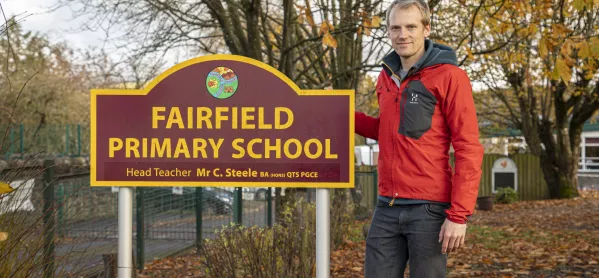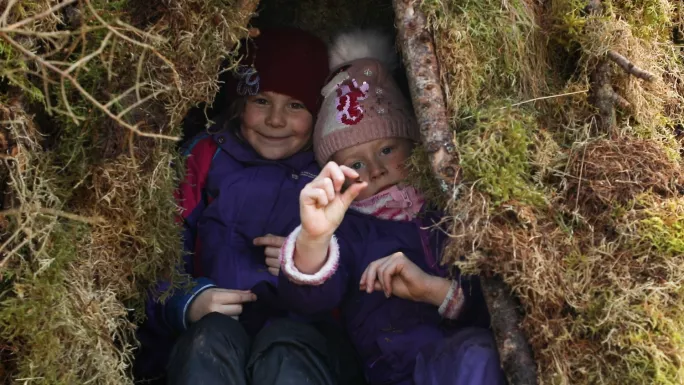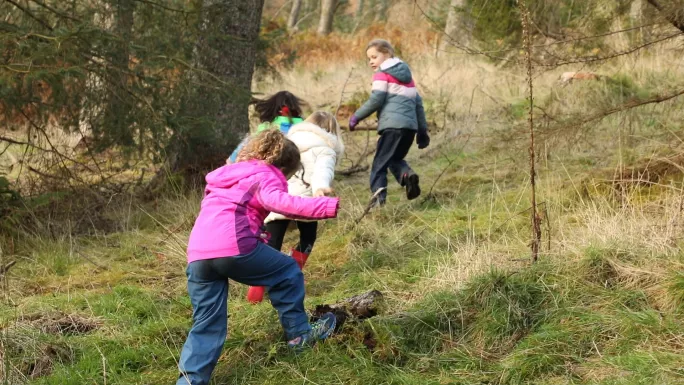
- Home
- Outdoor learning ‘makes lessons more memorable’
Outdoor learning ‘makes lessons more memorable’

In a shaded part of the Cumbrian fells, conifer branches shield the blazing campfire, as pupils from Fairfield Primary School take a short rest from their weekly “forest school”.
They sip hot chocolate before they resume building “dens” based on Stone Age shelters, replete with thick coverings of protective moss, more than a little reminiscent of the dwellings in Middle Earth.
Watch: Five ways to create a healthier school
News: Tes Awards: Healthy school of the year
Tes Schools Awards 2019: The winners
Related: DfE launches healthy schools rating scheme
Later, a group of pupils inspect the “doorframe” of their den, somewhat perturbed by a growth at its side.
“I think we’ve found some sort of fungus,” they say, frowning slightly. The children take the dens seriously - weeks of work have gone into equipping them with shelves and stools, while one even has its own wind-chime constructed from twigs and leaves.
While many schools run outdoor learning programmes, Fairfield, in the heart of the Lake District, is undeniably blessed by its surroundings. In June, it won Tes’ Healthy School of the Year award, and the idyllic scenery of the environment surely helps when it comes to promoting active lifestyles.

Focus on outdoor learning
As Fairfield’s headteacher, Chris Steele, says, most of the parents are supportive of the school’s approach.
“If you live around here, you like this sort of thing,” he explains. The children are “keen as mustard” when it comes to the outdoors, he adds.
“These kids scramble up the hills; they’re so used to it. But they’re also the least streetwise kids you’ll ever meet.”
Yet, while the setting is an advantage, Steele points out that although the environment has always featured in the curriculum, in the past few years this has “really been pushed to the front”.
And, according to Steele, the best thing about prioritising outdoor learning is how this enhances, rather than diminishes, the rest of the curriculum.
“We have a finite number of hours in a day, and a finite list of resources. In any school you go to - you might go to an ‘outstanding’ reading school, or an ‘outstanding’ school for maths - it is just about prioritisation.
“What do you put as the most important thing within the day? There are so many things to squeeze in. One of our key priorities is the outdoors and active lifestyles, so you will see it in everything.
“The beauty of that, I think, is that it does not come at the cost of other things. If you prioritise a curriculum area, you can lose out elsewhere, whereas our focus allows you to bring the other subjects along.”

Active learning is a core part of every aspect of the curriculum. Walking through the school, you can see a maths lesson in which groups of pupils search for clue-cards featuring long-division prompts, hidden in the bushes as part of a “treasure hunt”.
Outside another classroom, a spelling test is taking place, but one with a difference from the mute scribbling and crossings-out you might expect.
Pupils are assembled on the flagstones, coloured chalk in hand.
“Right, for the next one, we have to remember what Cher says. Which is...?” asks the teacher.
“Believe!” comes a chorus of voices, before the pupils inscribe the word on the ground.
“The next word is ‘Wednesday’. Wed-nes-day. And on Wednesdays, we are going to…jog on the spot!”
The pupils commence jogging furiously, before writing out the word. They are visibly enthusiastic, and while, admittedly, Tes visits on the day of BBC Children in Need, when many pupils are dressed as Pudsey, their engagement does not seem incidental, or for show.
‘It’s about establishing a culture’
Steele says the aim of outdoor learning is to make education memorable and engaging at all times.
“For us, it’s about establishing a culture - if you can get outside, do it,” he says.
“What people need to understand is that just because you’re outside doesn’t mean you’re not delivering your core curriculum.”
“That [outdoor experience] is something they’ll remember forever.”
Speaking to his own experience as a pupil, he explains: “As a child myself, I wanted to be outdoors, and sometimes you would lose focus in the classroom with the teacher droning on.
“I grew up with an active lifestyle, and I desperately wanted to do stuff outside all the time - that’s where a lot of my best memories are from school, the things I remember.
“If we get the engagement from the kids, that’s when they really link learning together. We try to break away from the classic classroom model.”

One way in which the school promotes activity is through issuing all pupils with their own activity passports. Depending on age, these feature targets such as accompanying an adult to skim stones across a nearby river, or practising a one-legged balance on a log. Once pupils have all the tasks stamped off, they are rewarded with a one-off pass to their local leisure centre.
Modelling active lifestyles also means engaging with parents. The school offers multi-activity sessions over six weeks as part of its “Active Families” programme, and these are available for children and families in the area who do not attend the school.
“It’s something that’s accessible, local and very cheap,” Steele explains - classes cost £1 per person.
Recently, a nutritionist also visited the school to coach pupils and parents about healthy eating habits, and Steele attended with his own children.
“It is hard to get your kid to eat healthy food, it really is - they are humans, they will naturally go for what they really want to eat, which is crisps,” he says.
“But she gave us lots of fun ways to do stuff, like making faces out of carrots or these celery and peanut butter caterpillars, with sultanas for legs - really lovely ideas, but for healthy snacking.”
That said, Steele points out that pupils only eat one meal a day at school, and that “we’re getting on to more political things, but it’s cheaper to buy a multipack of crisps than some celery and some peanut butter and more healthy kind of snacks”.
“We’re battling external factors on that, ” he goes on. “But we go as far as we can in educating the children around healthy eating, and we take it that step further by trying to educate the parents in healthy eating as well.”
While meals at home may be outside the remit of school staff, Steele says they aim to model healthy and active lifestyles as much as possible. He is an avid cyclist and former mountain rescue volunteer, and has competed as a fell runner at an international level. Walking through the school, you are more likely to see teachers dressed in wind-proof jackets than in suits.
‘We’re not all rugby players’
Steele emphasises that in order to ensure that all pupils take part in sport, they need to have a variety of options. The school has engaged pupils in sport through liaising with various local clubs; for example, arranging an orienteering event that included a course through the town using GPS, with over 200 people taking part. Cheerleading is on offer, too.
“It’s about making sure every child has an avenue - we’re not all rugby players,” Steele says.
“It’s profile-raising for us, and the orienteering club were bowled over - they’ve seen a surge of people going on Thursdays. It’s all about opening the door and sign-posting them in.”
There are three or four sports clubs on every night across all key stages. Steele and physical education lead Rob Barton proudly report that 75 per cent of pupils now represent the school in a sport after the senior team set this as a target.
This is despite the fact that, when Ofsted visited, inspectors felt that the target was overly ambitious, and warned that goals had to be achievable.
Now, the school is looking to raise the bar even higher so that the remaining 25 per cent of pupils are competing, too.
Getting local clubs involved is also helping to raise pupils’ aspirations. The girls’ rugby team won their last match - “they’re vicious”, says Steele - and the Newcastle Falcons Rugby team run a six-week programme teaching maths on the pitch through calculating rugby scores.
“If a child really wants to take a sport on further, they need to be developed through these connections with clubs,” the head says.
In addition, the school promotes active lifestyles through its “Grand Day Out”, when pupils are taken on extensive hikes through the local countryside. A recent trip involved a three-mile ascent of Barrow, a small fell, while Year 4 visited a slate mine as part of a study of the Stone Age.
A magical Midsummer Night’s Dream
Yet this focus on the outdoors also enriches academic learning in unique ways, too. For Erin Strickland, a Year 5 teacher, one of the highlights of the year is the children’s production of A Midsummer Night’s Dream, staged not in a school hall or classroom but within the shaded nooks of the woods themselves.
“It’s absolutely gorgeous,” Strickland says. “We get to know the play, and then the children dress the forest to make it a magical environment for the audience. It’s a moving open-air theatre, walking from scene to scene. It brings it to life - you have the forest fairies peeking behind the trees, flitting in the background.”
Another project has involved pupils working with the Manchester Camerata orchestra to create music based on the nearby landscape.
They accompanied guides on a walk near Grasmere and Dove Cottage to celebrate the 250th anniversary of Wordsworth’s birth, following Dorothy Wordsworth’s diaries for inspiration. The guides trailed headphones in the trickling streams to record natural sound, which will be combined with poems penned by the pupils.
“It’s basically about being inspired by their environment,” Strickland says. “It really adds something to their learning, but it’s so embedded now, it comes quite naturally.”
Part of their success also comes from how involved pupils are in decision making when it comes to sport. The school has a junior sports council, and it ran a competition to design the playground climbing wall.
Painted with mountain scenery and images of the changing seasons, it is also emblazoned with a quotation from the Scottish-American naturalist, John Muir: “The mountains are calling, and I must go.”
Given Fairfield’s location, the call of the outdoors is strong, but this has clearly been nurtured by the school to its fullest extent. As Steele says: “Being outside massively improves motivation - they’re very keen, they’re excited, and there’s always a new thing to be doing.”
“It’s very rare we get a kid unhappy at school,” he says, before conceding,“maybe if they’ve done too much and they’re knackered - ‘I can’t run another kilometre!’”
Register with Tes and you can read five free articles every month, plus you'll have access to our range of award-winning newsletters.
Keep reading for just £4.90 per month
You've reached your limit of free articles this month. Subscribe for £4.90 per month for three months and get:
- Unlimited access to all Tes magazine content
- Exclusive subscriber-only stories
- Award-winning email newsletters
You've reached your limit of free articles this month. Subscribe for £4.90 per month for three months and get:
- Unlimited access to all Tes magazine content
- Exclusive subscriber-only stories
- Award-winning email newsletters



